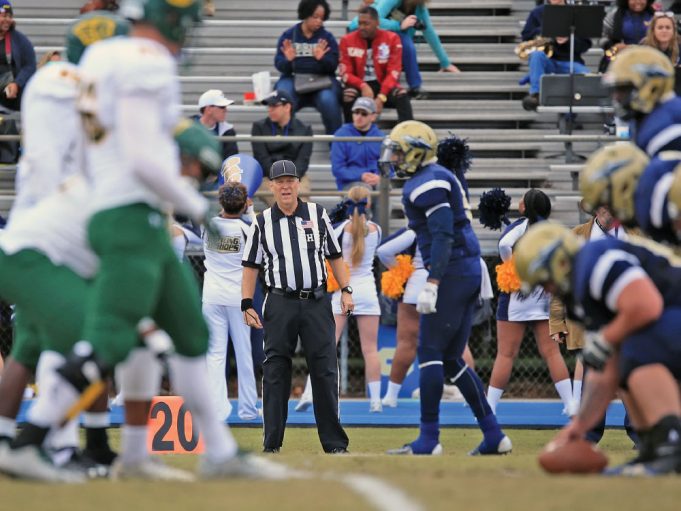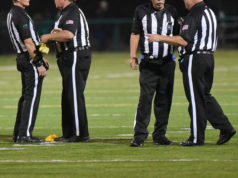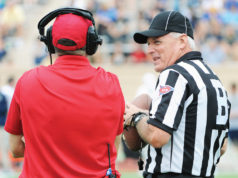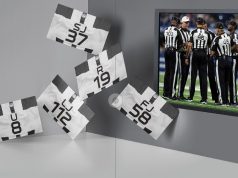O
ffensive players are prohibited from committing a false start before the snap. There are two movements that are illegal for all team A players: simulating action at the snap or intending to cause the defense to encroach. Furthermore, interior linemen (under NCAA rules, restricted linemen) are prohibited from moving a hand or making any quick movement after having placed a hand on or near the ground. All of those movements are subject to judgment by the officials.
Snaps are characterized by abrupt movement, meaning they are sudden, quick and unexpected. Thus, any such movement that is not part of the actual snap simulates action at the snap and is a foul.
Actions designed to cause the defense to encroach are more difficult to discern. If there is no apparent football purpose for the movement, it should be presumed the act was purely designed to cause encroachment by the defense. The game situation should be considered in making that judgment. Shifts on third or fourth down with less than five yards to go are more questionable than shifts in other situations. The official should also consider whether an unusual shift is used routinely beginning early in the game or as a surprise in the latter stages of the game.
The main purpose of a shift is to reduce the time the defense has to align itself to the offensive formation. It also creates the possibility that the defense will be confused and allow a receiver to go uncovered or to not have sufficient personnel on the side of the field to which the play will be run. Consequently, shifts that do not involve players changing position in the formation should be highly suspect. Those include linemen quickly rising upright in unison before going to a three-point stance (the so-called Dallas shift) and linemen in a hands-on-thighs position quickly going to a three-point stance in unison. The more players that shift simultaneously, the greater the likelihood that it will appear the snap is taking place. Missing the snap count might be the start of what is otherwise legal motion but it is likely to look like the start of the snap and that makes it a foul.
Under NCAA rules, if the offense never has all 11 players set for a full second, it is an illegal shift that converts to a false start (dead-ball foul, 7-1-2b-5), instead of a live-ball foul for an illegal shift (7-1-4c).
False starts must be judged on the acts of the offensive players and not upon the effect they have on the defense. Whether or not the action by the offense draws the defense into the neutral zone should not be the sole factor in determining if a false start has occurred, but marginal activity that does not cause encroachment can be the basis for advising the coach.
Defense.
Defensive players have a much greater degree of freedom to move than the offense. In fact, there are no restrictions on when and where team B players can move. They are only precluded from actions that induce a false start or interfere with team A’s signals.
Specifically, the defense is allowed to shift to either side of the formation or from lineman to linebacker or vice versa. Defenders who run toward the neutral zone attempting to time their blitz with the snap do not commit a foul unless they are guilty of encroachment (NFHS) or are offside (NCAA).
However, defensive players are not permitted to deliberately feint a charge to provoke team A linemen into moving. Team B players who are stationary within one yard of their line of scrimmage are prohibited from making quick non-football-related movements in an obvious attempt to draw an offensive player into committing a foul. Examples of violations include stomping a foot, clapping hands, quickly standing up or moving to a three- or four-point stance or vice versa, quickly bobbing the head or repeatedly and/or abruptly flexing legs or arms.
That is a disconcerting act and carries a five-yard penalty in NFHS and a five-yard penalty for delay in college play (NFHS 7-1-9; NCAA 7-1-5a-3). Consequently, any movement by a team A player is ignored. Movement by a team A player is not required in order for a defensive foul to occur.
The rule also prohibits any defensive player from using disconcerting words in an attempt to interfere with opponents when they are preparing to put the ball in play. Specifically mentioned are signals that simulate the sound or cadence of (or otherwise interfere with) offensive starting signals.
Restrictions on the defense begin when offensive players take their set positions. Special attention should be given to possible interference during the quarterback’s cadence, and particularly during an audible.
There are legitimate defensive signals which may need to be given immediately prior to the snap. Examples include putting a blitz on or off, changing pass coverage or telling defensive linemen to shift or stunt.
The challenge for officials is to determine what the defense is actually doing. Is it a legitimate call or is it is merely a ruse in an attempt to interfere? The offense has “first choice” of signals or cadence, and the defense is required to use, or change to, something completely different. Specific words which the defense should not be allowed to use include: “go,” “hike” or “hut.” Other words which are questionable and require greater judgment to discern their impact include “now” and “shift.” The use of “move” would be OK.
Since offenses use clapping as a means of signaling, the defense is not allowed to do the same. Furthermore, the defense cannot use general noise, growling or yelling in an attempt to prevent the offense from hearing its signals.
If possible, the defense should be cautioned first. If the attempt to interfere is successful and causes the offense to false start, or if the defense fails to heed the caution and repeats such words or acts, the defense should be penalized without hesitation.
What's Your Call? Leave a Comment:
Note: This article is archival in nature. Rules, interpretations, mechanics, philosophies and other information may or may not be correct for the current year.
This article is the copyright of ©Referee Enterprises, Inc., and may not be republished in whole or in part online, in print or in any capacity without expressed written permission from Referee. The article is made available for educational use by individuals.



















